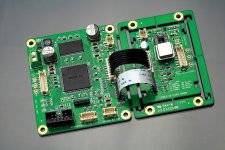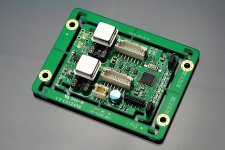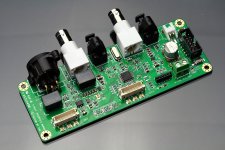Very nice. Will it be available soon?
Happy New Year! Just back to work from holiday. Hopefully I could show you something very soon.
Ian
Asynchronous I2S FIFO project R&D progress so far and the possible group buy (GB)
I opened this Asynchronous I2S FIFO developing thread on Jul 12, 2011. Six months have passed. And now, it seems that the project is going very well. As an audiophile and a R&D engineer, I have to say, this concept is really working.
What I have achieved so for are:
1. I2S FIFO Board with attached Single XO Clock Board (PCB is the third edition).
2. Dual XO Clock Board (PCB is the third edition).
3. S/PDIF Interface Board (PCB is the third edition).
Quite a few friends are very interested in this project, and some of them encouraged me setting up a group buy. I like that idea. Because, for me, it would my great pleasure if I could share the output of this project with other audiophiles by setting up a group buy. But to do so, there would be a great deal of jobs. Just let me figure it out.
Once I’m ready, I will open a new GB thread on the Commercial Sector / Group Buy area of DiyAudio Forums, while keep this thread for technical discusses only.
I attached the pictures of the three up to date PCB assembling boards and corresponding PDF user’s manuals below for reference.
Ian
I opened this Asynchronous I2S FIFO developing thread on Jul 12, 2011. Six months have passed. And now, it seems that the project is going very well. As an audiophile and a R&D engineer, I have to say, this concept is really working.
What I have achieved so for are:
1. I2S FIFO Board with attached Single XO Clock Board (PCB is the third edition).
2. Dual XO Clock Board (PCB is the third edition).
3. S/PDIF Interface Board (PCB is the third edition).
Quite a few friends are very interested in this project, and some of them encouraged me setting up a group buy. I like that idea. Because, for me, it would my great pleasure if I could share the output of this project with other audiophiles by setting up a group buy. But to do so, there would be a great deal of jobs. Just let me figure it out.
Once I’m ready, I will open a new GB thread on the Commercial Sector / Group Buy area of DiyAudio Forums, while keep this thread for technical discusses only.
I attached the pictures of the three up to date PCB assembling boards and corresponding PDF user’s manuals below for reference.
Ian
Attachments
Single PCB?
Hi Ian,
great project. A couple of questions.
What is the reason you choose to use three PCBs instead of one?
Even if someone doesn't need the SPDIF input, e.g. they want to use USB, the savings on PCB, interconnects etc. are probably in the range of the cost of the SPDIF section anyhow?
In your experience, what is the best performance in terms of jitter that can be achieved using an integrated (single chip or DSP e.g. ADI) ASRC vs your very nice design?
Hi Ian,
great project. A couple of questions.
What is the reason you choose to use three PCBs instead of one?
Even if someone doesn't need the SPDIF input, e.g. they want to use USB, the savings on PCB, interconnects etc. are probably in the range of the cost of the SPDIF section anyhow?
In your experience, what is the best performance in terms of jitter that can be achieved using an integrated (single chip or DSP e.g. ADI) ASRC vs your very nice design?
Hello Ian, can you enlighten me about the regulator for the clock. Does it have to be supplied externally?
zinsula,
Any 5V-6V regulated DC power supply is OK for the FIFO KIT, beacuse filters and low noise LDOs already equiped on board. However, if you have really nice low jitter clock, low noise high performance DC power supply is prefered for the last drop of juice. For eaxmple, the GB Salas low voltage shunt reg would be one of the good choices. Batteries could be good reference to help you making the right decision.
Usually you don't need external power supply for the clock board, because on board LDOs and filters for the clocks are independent from other sections.
Ian
Ian,
do I understand correctly:
- the clock board does have already the regulators on board
- there is no easy and meningful possibility to bypass them? (of course there is not much sense in placing the reg, as good as it might be, iches away from the clock)
I'm asking as low noise is of utmost importance for a good clock to perform at it's best,
and since I believe that no LDO will match a regulator eg. Demian has presented here.
Btw, did you already test the Tent clock?
do I understand correctly:
- the clock board does have already the regulators on board
- there is no easy and meningful possibility to bypass them? (of course there is not much sense in placing the reg, as good as it might be, iches away from the clock)
I'm asking as low noise is of utmost importance for a good clock to perform at it's best,
and since I believe that no LDO will match a regulator eg. Demian has presented here.
Btw, did you already test the Tent clock?
at these frequencies the decoupling caps will still do most of the heavy lifting in any regulator scenario anyway, so transient response is imo pretty meaningless, while low noise is still pretty meaningful, does demians regulator produce better than 9uV RMS? it may well do as the man knows what hes doing (yes i saved the schematic back then too), but yes you guessed it, the physical placement offboard is likely to render it fairly incidental
any upgrade i might play with might be batteries
any upgrade i might play with might be batteries
Hi zinsula,
Yes, the clock board already equiped with low noise regulators on board.
However optional external power input port has been left for skilled diyers,bypassing the onboard LDO is very easy as well, just disconnect some FBs. If you like, I could even supply clock board without LDO.
Talking about clocks, yes, I tested quite a few of them, include the Tent clock.
Ian
Yes, the clock board already equiped with low noise regulators on board.
However optional external power input port has been left for skilled diyers,bypassing the onboard LDO is very easy as well, just disconnect some FBs. If you like, I could even supply clock board without LDO.
Talking about clocks, yes, I tested quite a few of them, include the Tent clock.
Ian
boards arrived!! i'm having a bit of an issue here at the moment due to the weather, my workshop and bedroom literally flooded yesterday due to a blocked storm drain outside. Luckily i was home, so caught the problem before any actual water damage to any electronics, got about 5-10mm starting to come inside through the floor, but after about 30 minutes outside in the ******* rain i unblocked the drain and it all drained out again in a matter of minutes.
so no actual water damage to components, but i have to go buy a heap of desiccant to get rid of the damp before i go opening any new and conveniently sealed electronics. the boards look great though Ian, so time to start deciding what clocks i'm going to buy.
The statement above does not disagree with my post. but i would like you to show me a regulator that is effective enough at these high frequencies to not leave all of the heavy lifting to the decoupling caps. Salas himself and those in the thread when i asked about this, brought this up WRT the BJT version. i also stated that low noise is still important and asked how the reg you linked compares to the 9uV LDOs. so where exactly do you disagree?
when i find a regulator with better noise performance over the range of interest (and particularly down in the low frequency 'jitter band') than A123 batteries i'll consider it, but i think we'll find that any advantage will be wiped out by the fact the regulator is not as local.
i'm genuinely interested though, as i said i downloaded that schema at the time and i'll be doing some experiments, i love tweaking with power supplies, but whether its academic past the level supplied remains to be seen. all good fun though!
so no actual water damage to components, but i have to go buy a heap of desiccant to get rid of the damp before i go opening any new and conveniently sealed electronics. the boards look great though Ian, so time to start deciding what clocks i'm going to buy.
Low 1/f corner frequency IS important.
The statement above does not disagree with my post. but i would like you to show me a regulator that is effective enough at these high frequencies to not leave all of the heavy lifting to the decoupling caps. Salas himself and those in the thread when i asked about this, brought this up WRT the BJT version. i also stated that low noise is still important and asked how the reg you linked compares to the 9uV LDOs. so where exactly do you disagree?
when i find a regulator with better noise performance over the range of interest (and particularly down in the low frequency 'jitter band') than A123 batteries i'll consider it, but i think we'll find that any advantage will be wiped out by the fact the regulator is not as local.
i'm genuinely interested though, as i said i downloaded that schema at the time and i'll be doing some experiments, i love tweaking with power supplies, but whether its academic past the level supplied remains to be seen. all good fun though!
Last edited:
boards arrived!! i'm having a bit of an issue here at the moment due to the weather, my workshop and bedroom literally flooded yesterday due to a blocked storm drain outside.!
Just hope everything is OK. Good luck to you! Ian
thanks, yeah i think it'll be ok, its just really humid in there and slightly damp floor, like really humid, i moved everything really sensitive out, but i have many thousands in parts so i'm buying a few of these to pull the moisture out and some of these to scatter around in the storage. if the large ones can protect shipping containers from 'container rain' on long voyages i think it'll be fine here.
wow i didnt think the linked images would be that big lol
An externally hosted image should be here but it was not working when we last tested it.
An externally hosted image should be here but it was not working when we last tested it.
wow i didnt think the linked images would be that big lol
with rice though, you are really supposed to submerge the phone in it, there is not enough rice in china to submerge all of my electronic parts hehe.
hey Regal, i found i had some epsom here, ive baked it, went totally opaque white, which seems logical, but when its absorbed its full of water, does it turn back to clear? just some indication of it doing its job would be cool.
sorry for the OT Ian
hey Regal, i found i had some epsom here, ive baked it, went totally opaque white, which seems logical, but when its absorbed its full of water, does it turn back to clear? just some indication of it doing its job would be cool.
sorry for the OT Ian
Air flow dry everything quickly. Just use a air fan facing what to dry. As well as the dehumidifier, it works very well for the basement. Try to get one if it is possible. Hope everything is well with you. Ian
thanks, yeah thats what i'm doing, i think i'll be fine, nothing got actually wet except for the floor and bottom of the walls, came up from underneath so could have been worse, drained in a matter of seconds once i sorted the drain out; i noticed it while it was still slowly creeping across, its just a matter of trying to keep the damp air under control, problem is although its stopped at the moment, we have about another 500mm of rain forecast over the next 6 days
last year at this time we had the worst flooding in living memory with 70% of the state under water and now its starting again, something is foobared with the planet
- Home
- Source & Line
- Digital Line Level
- Asynchronous I2S FIFO project, an ultimate weapon to fight the jitter


